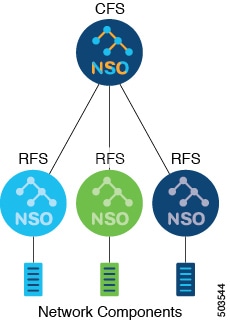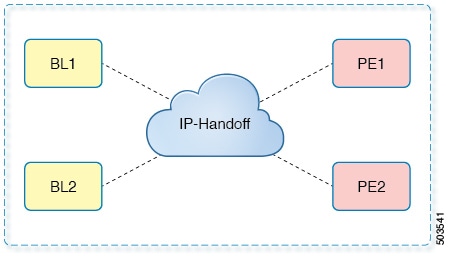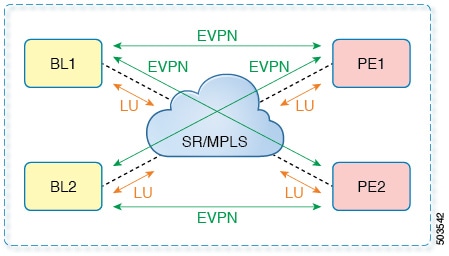About Cisco NSO and CFPs
Cisco Network Services Orchestrator (NSO) core function packs (CFPs) extend the NSO core platform to address specific use cases.
The documentation set for this product strives to use bias-free language. For the purposes of this documentation set, bias-free is defined as language that does not imply discrimination based on age, disability, gender, racial identity, ethnic identity, sexual orientation, socioeconomic status, and intersectionality. Exceptions may be present in the documentation due to language that is hardcoded in the user interfaces of the product software, language used based on RFP documentation, or language that is used by a referenced third-party product. Learn more about how Cisco is using Inclusive Language.
Cisco Network Services Orchestrator (NSO) core function packs (CFPs) extend the NSO core platform to address specific use cases.
Cisco Network Services Orchestrator (NSO) provides a robust bridge linking network automation and orchestration tools with the underlying physical and virtual infrastructure.
NSO provides a single, network-wide interface to all network devices and services, using a single-state model and configuration database. YANG models describe all NSO configuration, including device and service configurations. NSO includes a rich set of northbound software interfaces and APIs that allow straightforward northbound integration. An extensible southbound device abstraction layer allows NSO to work with multiple technology domains.
The following figure shows how NSO abstracts the configuration of Cisco ACI fabrics, allowing configuration based on YANG models.

Cisco NSO uses a Layered Services Architecture (LSA), in which a service is implemented in an upper-layer customer-facing (CFS) service and one or more lower-level resource-facing services (RFS) that interact with network components.

The LSA architecture provides these benefits:
High scalability
Automation across lower node domains and boundaries
Improved performance through parallel service execution
Allows rolling, granular upgrades and isolated testing
A Core Function Pack (CFP) is a ready-made add-on software package for NSO that is intended for a specific use case or a set of closely related use cases. Because the CFP is use-case driven instead of being general purpose, it can simplify configuration of the network function, exposing only the settings necessary for the application. The CFP can automate other areas of the configuration, it can validate the resulting configuration, and it can roll back the configuration if needed.
A CFP can comprise a bundle of packages, including device drivers, templates, and other CFPs. A CFP is a released software package, fully supported by Cisco TAC.
The Cisco NSO Data Center - Software Defined Networking (DC-SDN) CFP focuses on the provisioning of datacenter fabrics and domains connecting to datacenter fabrics. For example, this CFP allows you to provision an ACI fabric without the need to understand the details of the ACI-specific configuration model. The CFP provides the following functionality:
Provisioning and management of multiple ACI fabrics, Multi-Pod, and Remote Leaf (RL) networks
Telco datacenter (DC) provisioning, including DC handoff provisioning for both IP and segment routing (SR/MPLS) handoffs to the transport domain
Multi-domain orchestration across the DC and transport domains

The NSO DC-SDN CFP provides a single interface for many management and provisioning scenarios, including the following:
A single tool to automate and orchestrate the provisioning of multiple data centers
A single tool to manage data centers and transport networks
A tool to perform cross-domain orchestration between a data center and a transport network
The DC-SDN CFP, when combined with other CFPs, can be used to perform end-to-end service provisioning across data centers, transport networks, Network Functions Virtualization Infrastructure (NFVI) servers, and other domains
In this solution document, we will focus on the cross-domain orchestration between a data center and a transport network.
The Cisco NSO DC-Transport CFP, a component of the NSO DC-SDN CFP, provides multi-domain orchestration across the datacenter (DC) domain and the service provider (SP) domain. The DC-Transport package extends the DC-SDN CFP to allow NSO to configure the domain edge devices:
The border leaf (BL) switches that serve as the datacenter edge facing the transport network
The provider edge (DC-PE) routers that serve as the transport network edge facing the datacenter
In the DC-SDN solution, three NSO instances are used in a Layered Services Architecture (LSA), as shown in the following figure:

A customer-facing cross-domain "upper NSO" with the DC-Transport CFP provides the top-level orchestration for the two resource-facing "lower NSO" instances.
A Datacenter NSO with the DC CFP provisions the APIC controllers of the ACI datacenter.
A Transport NSO provisions the PE routers of the SP transport network, using three installed function packages:
The DC-Connector CFP to provision the handoff to the DC-PE router
The TSDN CFP to configure the segment routing in the transport network
The L3VPN function pack to provision the VPN services
This solution is capable of managing multiple ACI datacenters and multiple DC-PE devices through the single top-level NSO.
The DC and SP domains can be directly connected, as shown in Direct connection of DC to SP network, or connected remotely.
 Note |
Although the following figure shows the recommended connection using two BL switches and two DC_PE routers, you can also connect with one BL to one DC-PE or with two BLs to one DC-PE. |

The following figures show a remote connection between domains, using either the IP handoff method or the segment routing (SR/MPLS) handoff method.


The following documents are available for the NSO DC-SDN CFP:
Data Center – Software Defined Networking - Core Function Pack User Guide
Data Center – Software Defined Networking - Core Function Pack Installation Guide
Cisco DC-Transport YANG Models
These documents are bundled with the NSO software. To download the documents, go to the Cisco Software Download page and search for Network Services Orchestrator 5.x (or later).
For information about Cisco Network Services Orchestrator (NSO), go to http://cisco.com/go/nso or to the Cisco NSO documentation page.
You can find NSO tutorials, labs, and developer information on Cisco DevNet at https://developer.cisco.com/docs/nso/.
For detailed information about deploying, configuring, and using the Cisco ACI components and fabric, see the Cisco Application Policy Infrastructure Controller (APIC) documentation page. The ACI documentation includes technical references, troubleshooting guides, and white papers.